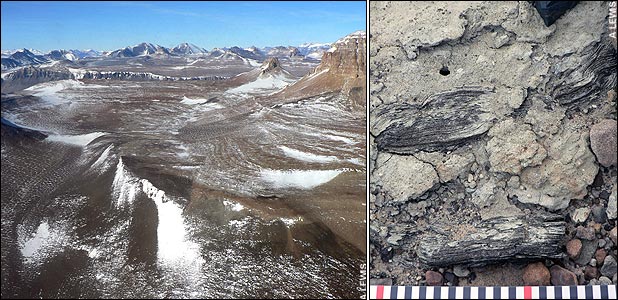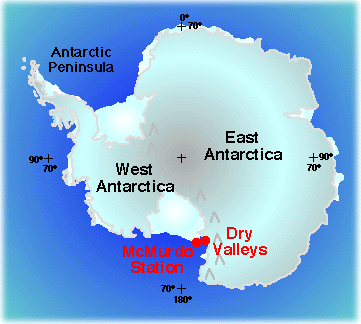|

04 August 2008
from
TheTelegraph Website
Spanish version
A lost world has been found in Antarctica, preserved just the way it
was when it was frozen in time some 14 million years ago.
The fossils of plants and animals high in the mountains is an
extremely rare find in the continent, one that also gives a glimpse
of a what could be there in a century or two as the planet warms.
|
 |
|
Mt Boreas in
the western Olympus Range, Dry Valleys (left) and moss
mat (right), the Dry Valleys climate prevented
decomposition |
A team working in an ice-free region has
discovered the trove of ancient life in what must have been the last
traces of tundra on the interior of the southernmost continent
before temperatures began to drop relentlessly.
An abrupt and dramatic climate cooling of 8°C in 200,000
years forced the extinction of tundra plants and insects and brought
interior Antarctica into a perpetual deep-freeze from which it has
never emerged, though may do again as a result of climate change.
An international team led by Prof David Marchant, at Boston
University and Profs Allan Ashworth and Adam Lewis, at
North Dakota State University,
 combined
evidence from glaciers, from the preserved ecology, volcanic ashes
and modeling to reveal the full extent of the big freeze in a part
of Antarctica called the Dry Valleys. combined
evidence from glaciers, from the preserved ecology, volcanic ashes
and modeling to reveal the full extent of the big freeze in a part
of Antarctica called the Dry Valleys.
The new insight in the understanding of Antarctica's climatic
history, which saw it change from a climate like that of South
Georgia to one similar to that seen today in Mars, is published in
the Proceedings of the National Academy of Sciences.
"We've documented the timing and the
magnitude of a tremendous change in Antarctic climate," said
Prof Marchant.
"The fossil found allow us to examine Antarctica as it existed
just prior to climate cooling at 13.9 million years ago. It is a
unique window into the past. To study these deposits is akin to
strolling across the Dry Valleys 14.1 million years ago."
The discovery of lake deposits with
perfectly preserved fossils of mosses, diatoms and minute
crustacea called ostracods is particularly exciting,
noted Prof Lewis.
"They are the first to be found even
though scientific expeditions have been visiting the Dry Valleys
since their discovery during the first Scott expedition in
1902-1903," he said.
"If we can understand how we got into this relatively cold
climate phase, then that can help predict how global warming
might push us back out of this phase.
For the vast majority of Earth
history there was no permanent ice like is common today at the
poles and even the tropics at high elevation. There's been a
progressive cooling going on for 50 million years to get us into
this permanent-ice mode; the formation of a permanent ice sheet
on Antarctica plays a big role in that cooling.
"Studies like ours that establish when and how climate
thresholds were crossed along the way can be used to predict
climate thresholds going the opposite direction, from cool to
warm.
"Although, to be fair, we're looking at one that is very far
away; warming would have to be greater than what is predicted
for the next one or two centuries to cause a melting of the East
Antarctic Ice Sheet. The west Antarctic Ice Sheet is much more
vulnerable.
Prof Ashworth is struck by how
species of
diatoms and
mosses are indistinguishable
from living ones.
Today they occur throughout the world -
except Antarctica.
"To be able to identify living
species amongst the fossils is phenomenal. To think that modern
counterparts have survived 14 million years on Earth without any
significant changes in the details of their appearances is
striking.
It must mean that these organisms
are so well-adapted to their habitats that in spite of repeated
climate changes and isolation of populations for millions of
years they have not become extinct but have survived."
What caused the big freeze is unknown
though theories abound and include phenomena as different as the
levels of carbon dioxide in the atmosphere and tectonic shifts that
affected ocean circulation.
|



 combined
evidence from glaciers, from the preserved ecology, volcanic ashes
and modeling to reveal the full extent of the big freeze in a part
of Antarctica called the Dry Valleys.
combined
evidence from glaciers, from the preserved ecology, volcanic ashes
and modeling to reveal the full extent of the big freeze in a part
of Antarctica called the Dry Valleys.